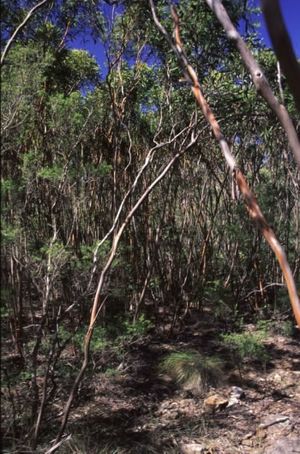Singleton mallee facts for kids
Quick facts for kids Singleton mallee |
|
|---|---|
 |
|
| Scientific classification | |
| Genus: |
Eucalyptus
|
| Species: |
castrensis
|
The Eucalyptus castrensis, often called Singleton mallee or Pokolbin mallee box, is a special type of mallee tree. A mallee is a eucalyptus plant that grows with many stems from a single underground root. This tree is found only in a small part of New South Wales, Australia.
It has smooth bark and leaves shaped like a spear. Its flower buds grow in groups of seven, and the flowers are white. When the flowers are gone, they leave behind cup-shaped fruits.
Contents
What Does the Singleton Mallee Look Like?
The Singleton mallee is a type of tree that usually grows up to 8 metres (26 ft) tall. It has smooth bark that looks bronze-grey. Sometimes, older parts of the tree might have rough bark near the bottom.
Leaves and Flowers
Young Singleton mallee plants have dull, bluish-green leaves. These leaves can be shaped like an egg or a spear. They are about 60–115 mm (2–5 in) long and 15–40 mm (0.6–2 in) wide.
As the tree gets older, its leaves become shiny green and spear-shaped. These adult leaves are 60–130 mm (2–5 in) long and 8–22 mm (0.3–0.9 in) wide. They grow on a small stem called a petiole, which is about 4–15 mm (0.2–0.6 in) long.
The flower buds grow in groups of seven. Each group is on a stalk called a peduncle, about 7–10 mm (0.3–0.4 in) long. Each individual bud has its own tiny stem, called a pedicel, about 1–5 mm (0.039–0.197 in) long.
The buds themselves are oval-shaped. They are about 5–6 mm (0.20–0.24 in) long and 2–4 mm (0.079–0.16 in) wide. They have a cone-shaped cap called an operculum. This tree usually flowers in August, and its flowers are white.
Fruit
After flowering, the tree produces woody, cup-shaped fruits. These fruits are called capsules. They are about 4–5 mm (0.16–0.20 in) long and 4–6 mm (0.16–0.24 in) wide. The parts that open to release seeds are found below the rim of the fruit.
How Did the Singleton Mallee Get Its Name?
Scientists gave the Eucalyptus castrensis its official name in 2002. A botanist named Ken Hill first described it. He found a sample of the tree at the Singleton Army Base.
The name castrensis comes from a Latin word, castra, which means "camp." The ending -ensis means "of" or "from." So, the name means "from the camp." This name was chosen because the tree was found on an army base.
Where Does the Singleton Mallee Grow?
The Singleton mallee is very rare. It is only known to grow in one dense group of trees. This group is located on an army base near Singleton. It grows on a low, wide ridge made of sandstone.
Is the Singleton Mallee in Danger?
Yes, this special eucalyptus tree is considered "endangered." This means there are very few of them left, and they are at risk of disappearing. The New South Wales Government protects it under the Biodiversity Conservation Act 2016. This law helps protect plants and animals that are in danger.

